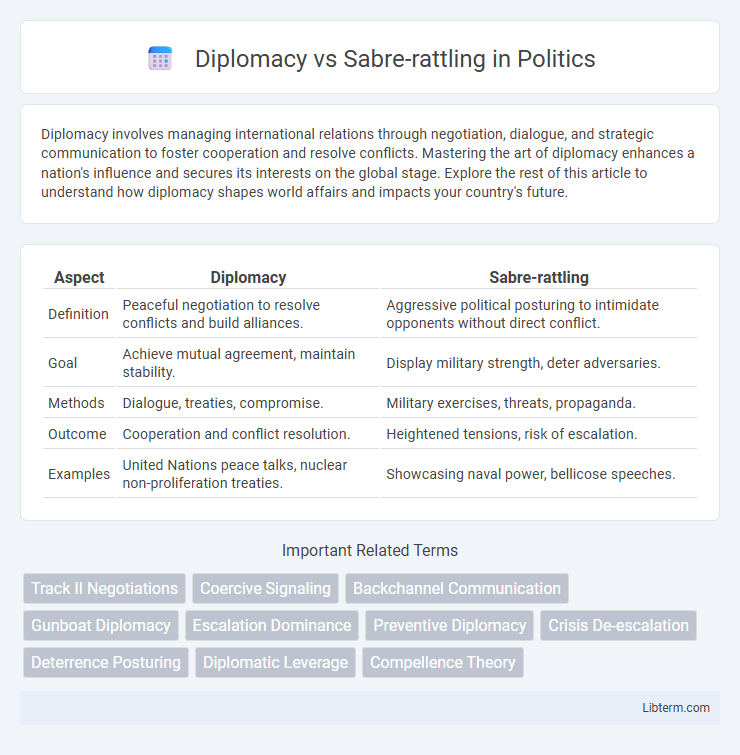Diplomacy involves managing international relations through negotiation, dialogue, and strategic communication to foster cooperation and resolve conflicts. Mastering the art of diplomacy enhances a nation's influence and secures its interests on the global stage. Explore the rest of this article to understand how diplomacy shapes world affairs and impacts your country's future.
Table of Comparison
| Aspect | Diplomacy | Sabre-rattling |
|---|---|---|
| Definition | Peaceful negotiation to resolve conflicts and build alliances. | Aggressive political posturing to intimidate opponents without direct conflict. |
| Goal | Achieve mutual agreement, maintain stability. | Display military strength, deter adversaries. |
| Methods | Dialogue, treaties, compromise. | Military exercises, threats, propaganda. |
| Outcome | Cooperation and conflict resolution. | Heightened tensions, risk of escalation. |
| Examples | United Nations peace talks, nuclear non-proliferation treaties. | Showcasing naval power, bellicose speeches. |
Understanding Diplomacy: The Art of Peaceful Negotiation
Understanding diplomacy involves mastering the art of peaceful negotiation to resolve conflicts and build international cooperation. Effective diplomacy relies on communication, empathy, and strategic compromise to achieve mutually beneficial outcomes without resorting to military threats. Unlike sabre-rattling, which escalates tensions through aggressive posturing, diplomacy fosters dialogue and trust among nations to maintain global stability.
Defining Sabre-Rattling: Signals of Military Threat
Sabre-rattling refers to aggressive military posturing or provocative actions intended to signal potential use of force without actual combat engagement. These signals often include troop buildups, military drills near borders, or public threats by state leaders to intimidate adversaries and influence diplomatic negotiations. Such tactics aim to coerce or deter opponents through displays of military readiness while avoiding open conflict.
Historical Examples of Diplomacy and Sabre-Rattling
The Cuban Missile Crisis of 1962 highlights diplomacy's crucial role in averting nuclear war through back-channel negotiations between the U.S. and Soviet Union. Contrastingly, the saber-rattling preceding World War I, characterized by aggressive military posturing among European powers, escalated tensions leading to conflict. The 1989 fall of the Berlin Wall exemplifies successful diplomacy replacing saber-rattling by fostering peaceful German reunification and ending Cold War hostilities.
Key Differences Between Diplomacy and Sabre-Rattling
Diplomacy involves strategic negotiation and communication aimed at resolving conflicts and fostering cooperation between nations, emphasizing dialogue, mutual respect, and long-term relationship building. Sabre-rattling, by contrast, relies on aggressive posturing, threats, or military demonstrations to intimidate opponents and coerce favorable outcomes without direct conflict. Key differences lie in diplomacy's focus on peaceful conflict resolution and sabre-rattling's emphasis on power projection and psychological pressure.
The Psychological Impact on International Relations
Diplomacy fosters trust and cooperation by promoting open communication, reducing misunderstandings, and encouraging mutual respect among nations, which strengthens international stability. Sabre-rattling, characterized by aggressive posturing and threats, often escalates tensions and heightens fear, leading to increased mistrust and the potential for conflict. The psychological impact shapes decision-making processes, where perceived intentions influence whether states pursue peaceful negotiation or prepare for confrontation.
Success Stories: Diplomacy Preventing Conflict
Diplomacy has successfully prevented conflicts by fostering dialogue and mutual understanding, as seen in the Iran Nuclear Deal where negotiations averted potential military escalation. The Camp David Accords between Egypt and Israel exemplify how sustained diplomatic efforts ended decades of hostility. These success stories highlight diplomacy's power to resolve disputes peacefully without resorting to sabre-rattling or threats of force.
Risks and Repercussions of Sabre-Rattling
Sabre-rattling increases geopolitical tensions and heightens the risk of miscalculation or accidental conflict between rival states. The aggressive display of military threats can damage diplomatic relations, undermining trust and reducing the chances for peaceful negotiation. Economic repercussions often follow as markets react negatively to instability, impacting trade and foreign investment.
Case Studies: Modern-Day Applications
Diplomacy in modern conflicts often involves multilateral negotiations and strategic partnerships, exemplified by the Iran nuclear deal where diplomatic engagement curbed nuclear proliferation risks. In contrast, sabre-rattling, such as North Korea's missile tests, serves as a form of coercive signaling aimed at intimidating adversaries without direct conflict. Case studies reveal that successful diplomatic efforts typically reduce tensions and foster international cooperation, while sabre-rattling can escalate regional instability and complicate peaceful resolutions.
Choosing the Right Approach: Factors for Decision-Making
Effective decision-making between diplomacy and sabre-rattling depends on factors such as the nature of the conflict, the goals of the involved parties, and the potential consequences of each approach. Diplomacy offers long-term solutions through negotiation and mutual understanding, while sabre-rattling may serve as a show of strength to deter aggression but risks escalation. Assessing the opponent's intent, the international context, and domestic political pressures helps determine the appropriate balance between dialogue and military posturing for conflict resolution.
The Future of Conflict Resolution: Towards Balance
The future of conflict resolution hinges on striking a balance between diplomacy and sabre-rattling, where strategic dialogue complements displays of strength to deter aggression without escalating tension. Emerging international frameworks emphasize multilateral negotiations and confidence-building measures alongside calibrated military posturing to maintain stability. Advancements in technology and communication foster transparent engagement, reducing misunderstandings while preserving credible deterrence in global security dynamics.
Diplomacy Infographic

 libterm.com
libterm.com